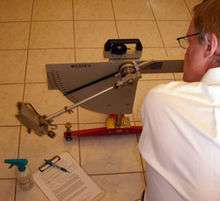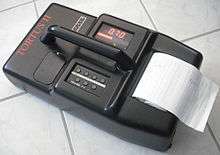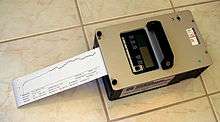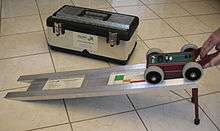Floor slip resistance testing
Floor slip resistance testing is the science of measuring the coefficient of friction (or resistance to slip accidents) of flooring surfaces, either in a laboratory (before or after installation) or on floors in situ. Slip resistance testing (or floor friction testing) is usually desired by the building's owner or manager when there has been a report of a slip and fall accident, when there has been a report of a near accident, or (preferably) before the flooring is installed on the property. Flooring is tested using a tribometer (floor slip resistance tester) to discover if there is a high propensity for slip and fall accidents on it, either dry and/or (most often) when wet with water or lubricated with other contaminants such as kitchen grease, hydraulic oil, etc. There have been numerous floor slip resistance testing tribometers and lab devices produced around the world to measure both the static (stationary) and dynamic (in motion) coefficient of friction, but presently there are only a few that have been proven to be reliable for obtaining useful safety results and that have current official test methods.
To assess a floor's slip resistance, a reliable, thoroughly researched (in interlaboratory studies) floor friction test method must be used, and then a minimum safety criterion (0.43, 0.60, 36, etc.) is needed to apply to the results. If the floor is likely to be lubricated with water or grease in use, it needs to be anti-slip under these expected conditions. Floor slip resistance testing can be carried out dry, wet with water, or lubricated with oils and other contaminants. Dry slip resistance is not an indicator of wet slip resistance — in fact the two often vary inversely — so reliable wet slip resistance testing is often needed as well as reliable dry testing.
Test methods and safety criteria
The Pendulum slip resistance tester

The ASTM E303-93[1] (United States) and BS EN 13036-4:2011[2] (United Kingdom) slip resistance test standards and AS 4663:2013 - Slip resistance of existing pedestrian surfaces and AS 4586:2013 - Slip resistance classification of new pedestrian surface materials (Australia), define the pendulum tester that is now a national standard for pedestrian slip resistance in 49 nations[2] on five continents and has been endorsed by Ceramic Tile Institute of America since 2001.[3][4] It is the most widely used pedestrian slip resistance test method worldwide. The pendulum uses a standardized piece of rubber (FourS rubber also known as Slider 96), which is set up to travel across the flooring sample for 123-125mm, mounted onto the pendulum foot. When the arm of the pendulum is set up to miss the flooring completely, the arm swings up to parallel from where it started, and the pointer (brought along by the arm holding the rubber slider) reads zero. Slippery flooring produces readings close to zero, and flooring which show higher resistance to slipping give results further from zero—high numbers (such as those 36 and above) indicating suitable slip resistant flooring.
The United Kingdom has since 1971 had well-established slip resistance standards based on the pendulum. This test was developed for pedestrian traction by the U.S. National Bureau of Standards in the 1940s and further refined in the UK.[5] It was validated for pedestrian traction in 1971, together with its safety standards, in the UK over a period of 25 years by 3500 real-world public walking area tests and site accident records.[6][7] The test is an ASTM standard (E 303), slightly modified for pedestrian traction. The usual safety standard for a level floor is a minimum Pendulum Test Value (PTV) of 36. The pendulum is also the instrument used in the Sustainable Slip Resistance test method, which measures the possible impact of years of use on a potential flooring's slip resistance. The pendulum is also used in the U.S. and elsewhere for determining the slipperiness of roads and airport runways.
Standards Australia HB 197:1999[8] as well as Standards Australia HB 198:2014 give detailed recommendations/guidelines of minimum wet Pendulum Test Slip Resistance Values for many different situations: e.g. external ramps, 54; external walkways and pedestrian crossings, 45; shopping center food courts, 35; and elevator lobbies above external entry level may be 25 or less. There are also barefoot area recommendations based on pendulum tests with a soft rubber slider (TRL rubber also known as Slider 55). The Australian recommendations are presently the world’s most detailed standards for pedestrian wet slip resistance.
Tortus digital tribometer

The Tortus digital tribometer slip resistance test method is based on a proprietary or patented device, which makes it ineligible to become an ASTM standard. It is produced in the U.K., and is in a category of slip resistance tester devices known as "drag-sled meters", which means that it travels across flooring under its own power at a constant speed with a piece of standardized rubber dragging on the flooring. The amount of friction created by this piece of rubber as it is dragged across the flooring (dry or wet) is recorded and calculated by the machine as it travels a predetermined path length. An average number of dynamic coefficient of friction (DCOF) is calculated by the machine after its run across the flooring has been completed. This is recorded as the "DCOF", or the amount of friction necessary to drag (dynamic meaning "in motion") the standardized rubber across the flooring. High numbers (e.g. above 0.50) indicate that it is difficult for the machine to drag the rubber across the flooring because it is anti-slip, and low numbers (e.g. below 0.50) means that the rubber easily slides across the flooring and is therefore slippery.
The Tortus is now the primary instrument for assessing dry slip resistance in the latest Australian slip test standard - AS4586-2013.[9] It has also been endorsed as a secondary standard by Ceramic Tile Institute of America (CTIOA) since 2001, with the pendulum being the primary standard. The advantage of the Tortus, compared to the pendulum, is that it can perform many slip tests in a short period of time, dry and wet, using both hard and soft rubbers. It is also difficult for the operator to influence the results of the test (unlike some tribometers) since an electronic button is pushed and then the test is run without any further help from the operator. This makes it a credible forensic science device. CTIOA has endorsed a minimum dynamic coefficient of friction for level floors of 0.50 using the Tortus slip resistance test method.[10]
BOT-3000 slip tester

America's ANSI B101.3 test standard is essentially for use of the BOT-3000 digital tribometer, which measures dynamic friction at a lower speed than the pendulum. The BOT-3000 is also a drag-sled meter, which means that it crawls along the floor under its own power at a constant speed measuring the resistance to slip of a standardized piece of rubber loaded into the bottom of the machine. The BOT-3000 performs a test without human input except for the pressing of a button, making it more difficult for the operator to manipulate the results of the test. This makes the instrument more credible in a court of law, as well as many other features that help in validating a test, such as the date of last calibration by the manufacturer, date and time of last verification by the user, and the date and time of the test run as well as the slider material used (e.g. SBR (hard) rubber, TRL (soft) rubber, leather, etc.). The latest model, the BOT-3000E, even takes photos of the floor in front of itself while running the test, adding even more to its courtroom credibility.
The safety standards ANSI specifies for a level floor using the B101.3 dynamic test method is that a flooring having a minimum dynamic coefficient of friction (DCOF) of 0.43 has “high slip resistance”. If the DCOF falls within the 0.30-0.42 range, then the test method states that the flooring is "acceptable, with an increased probability of slipping," and values below 0.30 are categorized as “low slip resistance" and a "higher probability of slipping".[11] The standard also specifies a minimum DCOF of 0.46 for ramps. With an official test method and a safety criterion, this test is useful in determining the anti-slip properties of flooring, helping building owners and managers to avoid future slip and fall accidents (by taking remedial steps to remedy slippery flooring), or help avoid losing a lawsuit based on a fraudulent accident.
The ANSI A137.1 [12] test method for assessing floor friction is referenced in the definition of porcelain tile 2012 International Building Code.[13] The 2012 International Building Code, as sold by the International Code Council, does not strictly adopt ANSI A137.1 with respect to floor surface testing. However, municipalities that adopt the code are free to create amendments, and may choose to adopt the standard. Although this test method is loosely based on research that was done using the ANSI B101.3 test method discussed above, the ANSI A137.1 [14] test method is apparently not based on a correlation to human traction tests or any justifiable level of slip risk. It is a pass/fail test method using the BOT-3000 where any level indoor flooring expected to get wet in use must have a DCOF of 0.42 or greater when wet to be acceptable for use.
The BOT-3000 has passed the ASTM F2508-13 [15] standard published in 2013 called the "Standard Practice for Validation, Calibration, and Certification of Walkway Tribometers Using Reference Surfaces". Although this test is necessary for a tribometer to pass, it is not sufficient in validating a tribometer as indicative of the human traction potential of a walking surface. Although this ASTM test method was created with good intentions, the test is often conducted and interpreted by people who have a vested interest in their tribometer having passed the test. In other words, a tribometer having passed this test should not be solely relied upon in deciding whether a certain tribometer is trustworthy or not. A reliable tribometer will also be able to submit a reasonable precision statement as required by every test standard-publishing agency, such as the ASTM, ANSI, Standards Australia, and British Standards. A tribometer with internationally accepted approval will have been found to correlate well with Variable-Angle ramp tests of human traction (see below), have an official and/or well-researched test method, and be able to provide a reasonable precision statement.
Variable-angle ramp
The Variable-Angle Ramp is a German-developed method for obtaining pedestrian slip resistance values. Flooring samples are mounted horizontally on the ramp tester and an operator clad in safety boots or bare feet performs a standardized walk up and down the sample while wearing a harness to stop the operator from being injured. The sample is slowly inclined until the operator slips on the surface. The angle at which the subject slips is then recorded. Two operators repeat this test three times and then an average is calculated.[16] The repeatability of this test method was extensively documented.[17] Tests can be performed dry, wet with soapy water, wet with oil, etc.
Over 150 safety criteria have been adopted in Germany and Australia for specific situations — swimming pool decks, commercial kitchens, restrooms, etc. based on the variable-angle ramp, but the ramp itself is not readily portable, so this instrument is only for lab testing and is therefore quite limited in its utility.[3][18] In other words, you can't test your specific floor tiles using this method without ripping part of your floor up and putting it into the ramp tester. However, since it is measuring real human ambulation, it is considered by many to be the most realistic test method in existence, and the results of pendulum and drag-sled meter tests are sometimes compared with results from variable-angle ramp tests to see if the results have a strong correlation. A good correlation with ramp test results can help a slip resistance test device become more widely used and accepted.
SlipAlert slip tester

SlipAlert is a matchbox car-like tribometer that is designed to mimic the readings of the pendulum. Manufactured in the United Kingdom, it is used for field testing, but is of limited use in a laboratory setting because it requires a long path length of flooring to conduct tests.[19] As it is a proprietary device, it does not have an official American standard test method, but it does have an official test standard in the United Kingdom in BS 8204-6:2008.[20]
The SlipAlert "car" has a rubber slider on its bottom, which slides across the flooring after running down a fixed ramp. If the SlipAlert stops short, then the flooring is slip resistant, but if it slides a long distance then the floor is considered slippery. There is a digital readout on the device that records the maximum distance the SlipAlert has traveled across the flooring, and a safety criterion graph which interprets the results. Tests can be done dry and wet, and extensive research by U.K. and Australian government agencies have resulted in several endorsements of this test device for in situ testing.
Withdrawn standards and unreliable test methods
ASTM C1028-07 - static coefficient of friction testing
Safety criteria based solely on static coefficient of friction (SCOF), often used in the U.S. for assessing safety, are too often misleading where flooring gets wet or otherwise lubricated in use. That is why the ASTM C1028 test method was officially withdrawn with no replacement in 2014.[21] In the USA, architects and designers generally look for a wet static coefficient of friction of 0.60 or higher by ASTM method C 1028 to assess potential safety for wet areas of level floors. This can give deceptive results, applying “safe” ratings to some flooring samples that are in fact very slippery when wet.[22] The method is now acknowledged by ASTM,[23] Ceramic Tile Institute of America,[24] and Tile Council of North America[25] to be inadequate for assessing slip safety.
See "external links" at the bottom of this page for more information on the inadequacies of the C1028 test. Suffering from stiction and the fact that the measurement taken is a measure of how slippery a surface is when someone is standing still on it (which is irrelevant to the measuring of the slip resistance to a person walking over the surface - where almost every accident occurs), methods such as C1028-07,[26] the James Machine, and the ASM 725/825A have very limited use in assessing wet floor friction and should not be solely relied upon.[3] These static test methods can be used to monitor changes in slip potential over time, but are not reliable tests for determining slip resistance of flooring. For example, static tests can be conducted before and after a fresh coat of wax is applied to a floor to make sure the SCOF has not changed dramatically with the new wax, or readings can be taken at various times during a business day to make sure that dirt and dust is not making the flooring slip situation worse throughout the day. Monitoring changes in dry SCOF can be a useful practice. However, SCOF tests should never be used to determine if a floor is slippery when wet. The U.S. Occupational Safety and Health Administration (OSHA) has recommended an SCOF of 0.50 for workplace environments, but often flooring having a rating of 0.60 or greater (supposedly even more slip resistant than 0.50 flooring) is proven by reliable test devices (and multiple slip and fall accident victims) to be very, very slippery when wet using this test method. This ASTM test standard has expired, and there are no plans to renew it as it has caused more confusion than anything else.
English XL (VIT) and Brungraber Mark II (PIAST)
The former ASTM F1677 was the test method for the Brungraber Mark II (also known as Portable Inclinable Articulated Strut Tribometer or PIAST) device, and the former ASTM F1679 test method was written for the English XL Variable Incidence Tribometer (VIT). Shortly after being published in 2004, ASTM withdrew these standards in 2006, with no replacement. (They are still available for purchase from ASTM as a withdrawn or "historical" standard.) Regarding ASTM F1679, ASTM provides the following 'withdrawn rationale': "Formerly under the jurisdiction of Committee F13 on Pedestrian/Walkway Safety and Footwear, this test method was withdrawn as an active ASTM standard by action of the Committee of Standards (COS) on September 30, 2006 for failure to include an approved precision statement (violating Section A21 of the Form and Style for ASTM Standards), and for including reference to proprietary apparatus where alternatives exist (violating Section 15 of the Regulations Governing ASTM Technical Committees)."[27] ASTM offers the following, similar 'withdrawn rationale' for F1677: "Formerly under the jurisdiction of Committee F13 on Pedestrian/Walkway Safety and Footwear, this test method was withdrawn as an active ASTM standard by action of the Committee of Standards (COS) on September 30, 2006 for failure to include an approved precision statement (violating Section A21 of the Form and Style for ASTM Standards), and for including reference to proprietary apparatus where alternatives exist (violating Section 15 of the Regulations Governing ASTM Technical Committees)." [28] Using these two instruments, different test labs got very different answers on identical tiles in interlaboratory studies, meaning these test methods (or devices) were unreliable and unable to provide "reasonable precision statements". The English XL is still used widely in the U.S., mostly by professional expert witnesses, who have discovered that the result of the test can be greatly influenced by how the actuating button is pressed by the user. This problem of precision can be used to their advantage in legal issues regarding slips and falls.
References
- ↑ American Society for Testing and Materials, “ASTM E303-93(2008),” ASTM 2008, West Conshohocken, PA, USA
- 1 2 British Standards Institution, “Road and airfield surface characteristics. Test methods. Method for measurement of slip/skid resistance of a surface. The pendulum test,” BSI 2011, London, England
- 1 2 3 Sotter, G., STOP Slip and Fall Accidents!, 2000, 204 pp., amazon.com
- ↑ CTIOA (a), Ceramic Tile Institute of America, “Floor Safety Reports: No. 3, Endorsement of Improved Test Methods and Slip Prevention Standards for New Flooring,” ibid., 2001
- ↑ Giles, C., Saby, B, and Cardew, K., “Development and Performance of the Portable Skid-Resistance Tester,” 26 pp., Department of Scientific and Industrial Research Road Research Laboratory Technical Paper No. 66, Her Majesty’s Stationery Office, 1964, United Kingdom
- ↑ Greater London Council, GLC Bulletin No. 43, March 1971, London, United Kingdom, available in pdf form at SafetyDirectAmerica.com, “Testing and Instruments — Pendulum”
- ↑ Greater London Council, GLC Bulletin 145, February 1985, ibid
- ↑ Standards Australia, “HB 197:1999,” Standards Australia 1999, Australia
- ↑ SAI Global, AS4586-2013 - Slip resistance classification of new pedestrian surface materials, 2013, http://infostore.saiglobal.com/store/details.aspx?ProductID=1636572
- ↑ CTIOA (a), Ceramic Tile Institute of America, “Floor Safety Reports: No. 1, Portable Methods,” ctioa.org, 2001
- ↑ ANSI, B101.3 - Test Method for Measuring Wet DCOF of Common Hard-Surface Floor Materials, 2012, http://www.nfsi.org/ansi_b101_3.php
- ↑ http://webstore.ansi.org/RecordDetail.aspx?sku=ANSI+A137.1%3A2012
- ↑ http://publicecodes.cyberregs.com/icod/ibc/2012/
- ↑ http://ansi-a137-1-tile-slip-test.info/
- ↑ http://www.astm.org/Standards/F2508.htm
- ↑ Health and Safety Executive, “The 3 ramp tests outlined in British and European standards,” HSE 2009, England
- ↑ Jung, K. and Schenk, H., “Objectification and Accuracy of the Walking Method for Determining the Anti-Slip Properties of Floor Surfaces,” (in German) Zentralblatt for Industrial Medicine, Accident Prevention and Ergonomics, 39, No. 8, 1988, pp 221–228, Germany
- ↑ CTIOA (b), Ceramic Tile Institute of America, “Floor Safety Reports: No. 3, Endorsement of Improved Test Methods and Slip Prevention Standards for New Flooring,” ibid., 2001
- ↑ SlipAlert, “SlipAlert.com,” 2011, http://www.slipalert.com/Home/about-slipalert.htm
- ↑ http://www.standardscentre.co.uk/bs/BS-8204-6-2008-A1-2010/
- ↑ http://www.astm.org/Standards/C1028.htm
- ↑ Powers, C., et al., “Assessment of Walkway Tribometer Readings in Evaluating Slip Resistance: A Gait-Based Approach,” J Forensic Sci, March 2007, 52, No. 2, pp. 400-405
- ↑ ASTM, American Society for Testing and Materials subcommittee 21.06, meeting minutes, May 3, 2005, Orlando, Florida USA, 26 pp.
- ↑ CTIOA (b), Ceramic Tile Institute of America, “Floor Safety Reports: No. 1, Portable Methods,” ctioa.org, 2001
- ↑ Astrachan, E., “Installer Update: Updates to an American Method for Measuring Coefficient of Friction.” TileDealer, November/December 2007
- ↑ Sotter, G., “C1028.info,” 2011, http://www.C1028.info
- ↑ American Society for Testing and Materials, “ASTM F1679-04e1 Standard Test Method,” Withdrawn 2006, http://www.astm.org/Standards/F1679.htm
- ↑ American Society for Testing and Materials, “ASTM F1677-05 Standard Test Method,” Withdrawn 2006, http://www.astm.org/Standards/F1677.htm
External links
- Video demonstration of Slip Test Devices on YouTube
- C1028-07 test: More information on the inadequacies of C1028-07 static test
- Read more information and see video on Pendulum Slip Tester - How it works
- Slip Test Instruments - several video demonstrations
- More information on the ANSI A137.1 tile slip test in the 2012 IBC